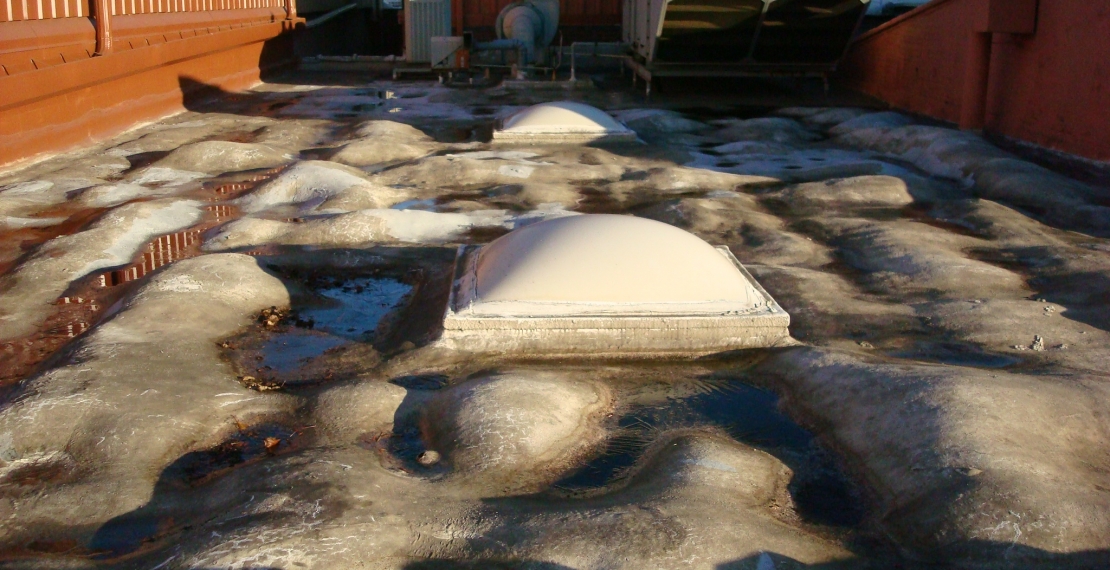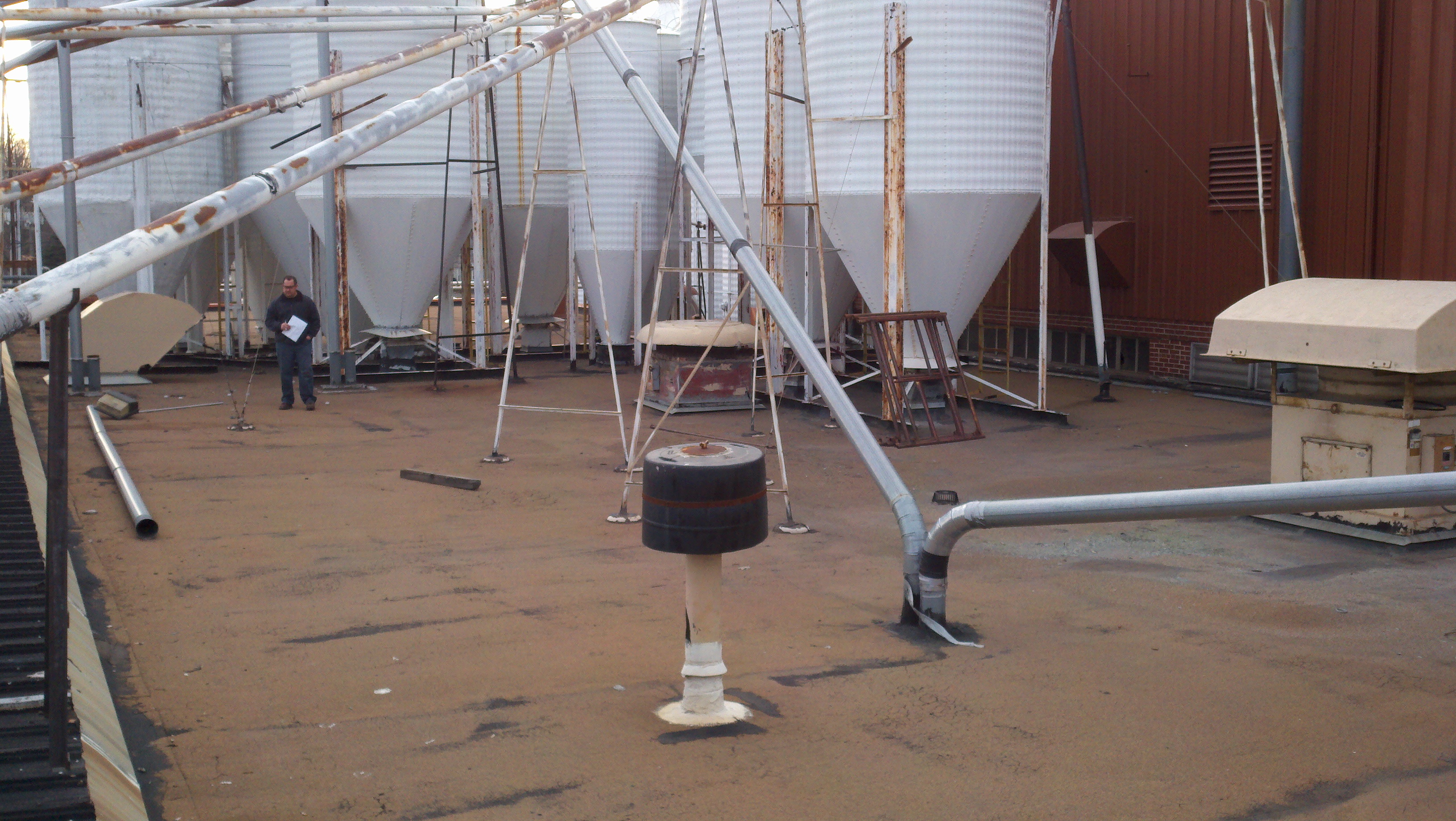The Top Ten Roofing Problems

By Kurt Baumgartner
In a recent article on Buildings.com, various roofing experts hold forth on "The Top 10 Most Common Roofing Problems" and how to avoid them. Since the article mostly reference built-up and modified roof problems, my list would be somewhat different since we deal with all types of roofing here.
The list, which I assume it is in order of severity is as follows.
- Roof leaks and moisture
- Blow offs, tenting and billowing
- Poor installation and unsatisfactory workmanship
- Lack of maintenance
- Ponding water
- Punctures, penetrations post installation
- Safety
- Improper repairs
- Shrinkage Blistering
Let's take a look at these one at a time.
 Roof leaks and moisture. Well "duh!" Anyone who knows that the primary purpose of a roof is to keep out the water. If that mission fails this is a serious problem, especially if not addressed promptly. Most leaks, though, are not the result of overall roofing failure but are incidental. The problem is not repairing them promptly. When water repeatedly enters the roof system, it can lead to roof failure.
Roof leaks and moisture. Well "duh!" Anyone who knows that the primary purpose of a roof is to keep out the water. If that mission fails this is a serious problem, especially if not addressed promptly. Most leaks, though, are not the result of overall roofing failure but are incidental. The problem is not repairing them promptly. When water repeatedly enters the roof system, it can lead to roof failure.
Blow offs, tenting and billowing. This, in my mind, is a much more serious problem than leakage. Ins ever instances, the roof may be gone! In the case of billowing and tenting, which is more problematic in single-ply roof membranes than built-up, the fatigue in some cases may lead to roof failure. In some mechanically-fastened systems, billowing is expected. If a roof is properly designed, under normal conditions this problem is eliminated. Under sever conditions, such as hurricanes or tornadoes, the damages is mitigated but not eliminated.
 Poor installation and unsatisfactory workmanship. Roofing contractors have gotten a bad rap on this one. There is no doubt that there are poor contractors out there, but the vast majority of contractors that I know are hard-working, honest businessmen who do their best. The way to eliminate this problem is to hire a professional contractor with a proven track record. By the way, the commentators on Buildings.com article were, for the most part, manufacturers of roofing materials. Poorly manufactured or poorly specified materials were nowhere in the list. That would have made my list.
Poor installation and unsatisfactory workmanship. Roofing contractors have gotten a bad rap on this one. There is no doubt that there are poor contractors out there, but the vast majority of contractors that I know are hard-working, honest businessmen who do their best. The way to eliminate this problem is to hire a professional contractor with a proven track record. By the way, the commentators on Buildings.com article were, for the most part, manufacturers of roofing materials. Poorly manufactured or poorly specified materials were nowhere in the list. That would have made my list.
Lack of maintenance. This is the most important thing, and should be at the top of anyone’s list. Regular inspections and roof maintenance are the single best way to lengthen roof life.
Ponding water. Most low-slope roofs will have some minor roof ponding. Most roofing professionals, both contractors and manufacturers, agree that ponds that last no longer than 48 hours after rainfall is not a problem. Major ponding, which can be the result of poor drainage design, roof deck deflection or equipment placed in the way of drainage, is a problem and should be addressed with tapered insulation systems or added drains.
Punctures and penetrations installed after the roof has been installed. This is a big headache for roofing contractors. Post-construction traffic and work can severely damage roof membranes and cause leaks. Many times another craft will penetrate the roof to install some piece of equipment, cables, supports or any number of items that are up on the roof. They then either attempt to make the repairs themselves, hire a different contractor than the original installer – or may even do nothing to fix the damage they’ve caused. All these scenarios are problems that lead to leaks and may void any warranty that may be in place. If you need to penetrate the roof, make sure the original install makes the repairs if at all possible.
 Safety. Although extremely important, I would not have included this on my list anymore than I would listed insurance or work force staffing. All three of these are problems in roofing and other industries, but this is a discussion of the roof itself and not the industry. I would say make sure your contractor has a written safety program and uses it. Furthermore, make sure only authorized personnel who are trained to work on the roof safely and know ho to avoid damaging the roof membrane get roof access. Your safest move is to hire a roofing professional to do regular inspections and maintenance work.
Safety. Although extremely important, I would not have included this on my list anymore than I would listed insurance or work force staffing. All three of these are problems in roofing and other industries, but this is a discussion of the roof itself and not the industry. I would say make sure your contractor has a written safety program and uses it. Furthermore, make sure only authorized personnel who are trained to work on the roof safely and know ho to avoid damaging the roof membrane get roof access. Your safest move is to hire a roofing professional to do regular inspections and maintenance work.
Improper repairs. A cheap fix may cost a fortune later on down the road. Use a reputable and professional contractor to make repairs to your roof.
Shrinkage. Some roofing membranes naturally shrink, and some don’t. Problems that relate to this are pulled wall flashing, damage at roof penetrations, splits and ruptures at seams. These may be solved with proper attachment and the installation of expansion joints and roof are dividers that limit the size of roof areas.
Blistering. This is usually a problem in hot asphalt systems and can be a problem when there is foot traffic or hail. They are cosmetically unsettling, but it is a common misperception that they leak. Unless ruptured from some outside source, blisters do not leak.
These then are the top ten villains in the roof membrane story. They all aren’t on my list, but most are.
The good news is the most of these problems may be avoided by getting your professional roofing contractor involved from the start to the finish on your next roofing project.
Kurt Baumgartner is chief technical advisor for the Midwest Roofing Contractors Association.

